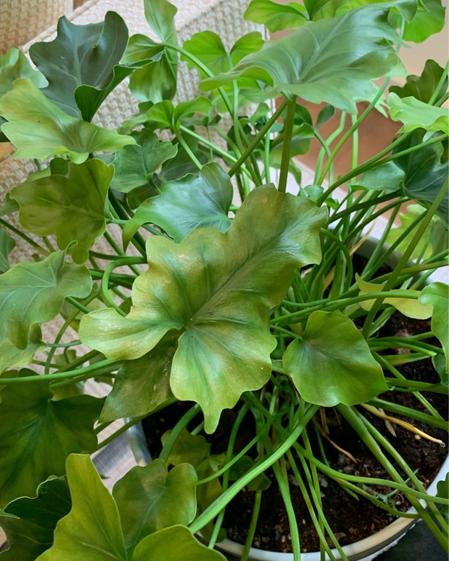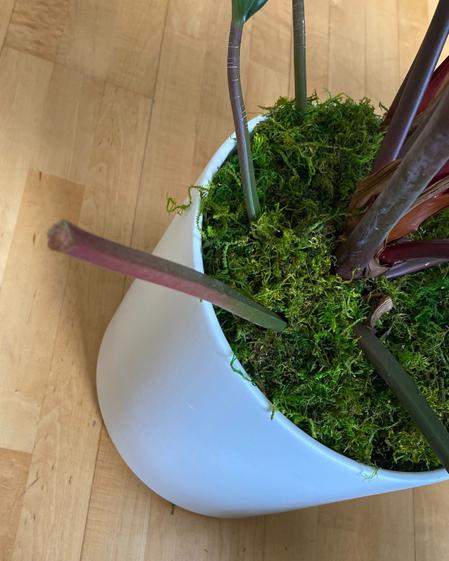{{ this.results.length }} Results
Your search for {{ this.pattern }} didn't return any results.
Philodendron Care Guide

Philodendrons such as the Hope Philodendron, Red Congo and Philodendron Brasil are classic, easy care indoor plants, loved for their lush greenery, trailing vines, and laid-back nature. With a wide variety of shapes, sizes, colors and leaf styles—from heart-shaped to deeply lobed—there’s a Philodendron to match any space or aesthetic. Whether you’re drawn to a bold, leafy statement or something soft and trailing, Philodendrons offer beauty and ease in equal measure. Read on to learn how to care for these versatile, easygoing favorites.
Simple Care Instructions for the Philodendron
Light Requirements
Philodendrons thrive in bright, indirect light but are incredibly adaptable and can tolerate lower light environments as well. Vining varieties, like the Philodendron Brasil, are especially forgiving in low-light spaces, while others, such as the Philodendron Birkin or Selloum, prefer moderate to bright indirect light for best growth. Be sure to keep them out of direct sun, which can scorch their delicate leaves.
Watering Needs
Philodendrons prefer moderate watering, allowing the top 1–2 inches of soil to dry out before watering again. These plants don’t like to sit in soggy soil, and overwatering is one of the most common problems—often leading to root rot. It’s better to underwater slightly than to keep the soil too wet. Most Philodendron varieties will be happy with watering about once every 1–2 weeks, depending on your home’s temperature, light, and humidity levels.
Need some watering support? Use a moisture meter to always know the best time to water your Philodendron. Shop our favorite minimalist moisture meter here.
Humidity and Temperature
Philodendrons do well in average indoor humidity but enjoy a boost in moisture, especially during the drier winter months. While they can tolerate lower humidity, regular misting or placing them near a humidifier can help prevent leaf browning and keep their foliage looking lush.
In terms of temperature, Philodendrons prefer a comfortable range between 65–80°F (18–27°C). They do not do well in cold temperatures, so keep that in mind in the winter, especially if you travel.
Soil and Fertilizing
Philodendrons thrive in well-draining, airy soil that holds some moisture without becoming waterlogged. A high-quality indoor potting mix with added perlite or orchid bark is ideal for promoting healthy root growth and good drainage. Avoid heavy or compacted soils, which can trap water and increase the risk of root rot.
For feeding, use a balanced liquid fertilizer during the growing season—typically spring and summer. Philodendrons are relatively low feeders, so follow the package instructions carefully to avoid fertilizer burn, which can show up as browning on the leaf tips. In fall and winter, when the plant’s growth naturally slows, it's best to reduce or skip fertilizing altogether.
Common Problems and Troubleshooting Tips
Yellow Leaves – Overwatering or Lack of Light
Symptoms: Leaves turning yellow, often starting with the older, lower leaves.
Cause: The most common reason for yellowing leaves in Philodendrons is overwatering, which can lead to soggy soil and poor root health. A lack of sufficient light can also contribute to yellowing, especially in low-light conditions.
Solution: First, check the soil—if it's overly wet, allow it to dry out before watering again, and ensure the pot has proper drainage. Adjust your watering schedule as needed. If the plant is in a low-light spot, try moving it closer to a source of bright, indirect light. Trim yellow leaves if desired to keep the plant looking its best.
Brown Spots – Overwatering or Fungal Issues
Symptoms: Soft, wet brown spots appearing on both new and older leaves.
Cause: These spots are often caused by overwatering, which can lead to fungal or bacterial infections in the foliage. Poor air circulation or consistently damp conditions can worsen the issue.
Solution: Check if the soil is waterlogged. Remove the plant from its plastic nursery pot and inspect the roots—if they appear mushy or smell foul, root rot may be present and repotting is necessary. If the soil is just slightly damp, place the plant in a well-ventilated area with bright, indirect light and pause watering until the soil dries out. Be sure to use a well-draining potting mix moving forward.
Leaf Drop – Environmental Stress or Improper Watering
Symptoms: Leaves suddenly yellowing and falling off, often starting with older or lower leaves.
Cause: In Philodendron Red Congo, leaf drop is often a response to stress. This can be triggered by inconsistent watering (too much or too little), sudden temperature changes, low humidity, or a recent move. Overwatering is a particularly common cause, leading to root issues that cause the plant to shed leaves.
Solution: First, assess your watering routine—make sure you’re letting the top few inches of soil dry out before watering again. Ensure the plant is in a warm, draft-free spot with stable temperatures and good humidity. If the plant was recently moved or repotted, give it time to adjust. Occasional leaf drop is normal, especially for older leaves, but frequent or sudden loss is a sign to reassess its environment and care.
Leggy Growth – Not Enough Light
Symptoms: Long, stretched-out stems with sparse leaves; the plant appears less full or bushy.
Cause: Philodendrons, partiuclarly the Red Congo and Hope Philodendron, can tolerate moderate light, but if placed in a space that's too dim, they'll start reaching toward the nearest light source. This results in spindly, leggy growth as the plant stretches in search of more brightness.
Solution: Move your plant to a spot with bright, indirect light—near a north or east-facing window, or a few feet back from a sunny southern exposure. Rotate the plant regularly to encourage even growth. If natural light is limited, consider supplementing with a grow light. For more tips, refer to our lighting guide.
Dramatic Wilting or Soggy Leaves – Overwatering
Symptoms: Leaves appear limp, droopy, or mushy to the touch. Stems may also feel soft or waterlogged.
Cause: This type of wilting can be a result of either overwatering or shock due to extreme temperatures.
Solution: If your plant has recently been exposed to extreme cold or heat, it's possible that it may not recover. Prune the dead leaves back and be patient--sometimes what's below the soil is still alive and will begin to grow new leaves in no time! If your plant hasn't been subject to extreme temperatures, check for overwatering. Remove the plant from its pot and inspect the roots. If they appear mushy, brown, or smell unpleasant, root rot (overwatering) is likely and the plant should be repotted in fresh, well-draining soil after trimming away any damaged roots. If the roots are intact but the soil is very wet, let the plant dry out in a well-ventilated area and adjust your watering routine moving forward. Always ensure your pot has drainage holes, and avoid letting the plant sit in standing water.

Yellow leaves on a Hope Philodendron, possibly due to watering or over-fertilizing.

A Philodendnron Brasil after being left in freezing temperatures.

Red Congos can lose their leaves during periods of shock.
Seasonal Care Tips
Philodendrons thrive in bright, indirect light year-round, but it’s important to be mindful of their exposure to direct sunlight, especially during the hotter summer months. While they can tolerate some sun, too much direct exposure—particularly from southern or western-facing windows—can lead to scorched leaves. In the colder months, when sunlight is less intense, your Philodendron will appreciate a little extra warmth and light, so feel free to place it in its favorite spot.
As for growth, Philodendrons grow more actively in the warmer months (spring and summer), requiring a bit more water and occasional feeding. During fall and winter, when the plant's growth slows, reduce watering and avoid fertilizing as much to prevent overfeeding. Keep the plant in a stable, temperature-controlled spot, away from drafts or cold windows, and it’ll be just fine during the seasonal transition.
Philodendron Plant Varieties
Philodendrons are a popular group of tropical plants that are beloved for their lush foliage, air-purifying properties and relatively easy care. With many varieties available, here are a few well-known types that are perfect for adding a touch of greenery to your home:
Red Congo (Philodendron 'Red Congo')
A striking variety with deep, glossy red leaves that turn green as they mature, the Red Congo is known for its dramatic appearance and strong, upright growth. This variety adds a bold, tropical feel to any space and is quite easy to care for with proper light and watering.
Philodendron Brasil (Philodendron hederaceum 'Brasil')
This vining beauty is prized for its heart-shaped leaves with bold green and yellow streaks, creating a vibrant contrast that brightens up any room. The Brasil is an adaptable variety that thrives in moderate to bright, indirect light and is very forgiving when it comes to watering.
Hope Philodendron (Philodendron 'Hope')
With its large, elegant green leaves and slow-growing nature, the Hope Philodendron is perfect for creating a stunning focal point in your space. This variety is easy to care for, as it prefers indirect light and moderate watering, making it a great choice for plant lovers of all levels.
Philodendron Birkin (Philodendron 'Birkin')
The Philodendron Birkin is known for its eye-catching white and cream stripes that run through its dark green leaves. This variety is perfect for those looking for something unique and adds a touch of elegance to any collection. It thrives in bright, indirect light and requires regular, but not excessive, watering.
Philodendron Micans (Philodendron micans)
This trailing variety has velvety, heart-shaped leaves that change from bronze to deep green as they mature. The Micans is a great option for a hanging basket or as part of a plant display and thrives in bright, indirect light with occasional misting to keep its humidity needs met.